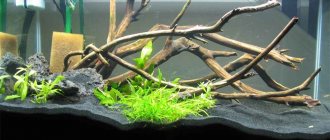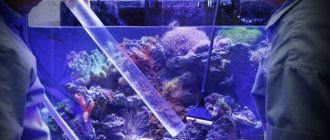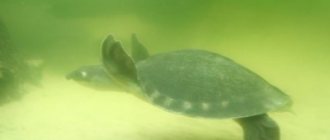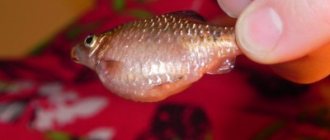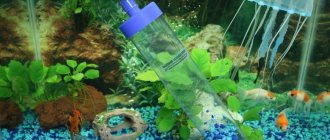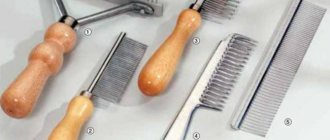Cloudiness of the water in an aquarium is a common event that terrifies novice fish keepers. When trying to purify water, beginners often make mistakes that lead to the liquid becoming more cloudy. In order not to aggravate the situation, you first need to figure out why the water in the aquarium is cloudy, and then begin to resolve the issue. Having figured out the cause of cloudy water in the aquarium, proven means and advice from experienced owners will help restore transparency.
Why did it become cloudy in the old and in the new, what is the difference?
Cloudiness in a new aquarium is normal and is due to the fact that the ecosystem has not yet stabilized.
It takes time for biological equilibrium to be established in it , when microorganisms are eaten by the inhabitants of the aquarium, and exactly as many bacteria are formed as necessary to maintain natural processes.
In an old aquarium, turbidity cannot appear just like that. And if this happens, it will not go away on its own until the cause is found out and measures are taken.
Causes of cloudy water
Cloudy water in an aquarium is a nuisance that fish keepers all over the world encounter every day. As you know, water is something without which fish cannot exist, so the purity and parameters of the liquid play a key role in maintaining underwater inhabitants. Having noticed that the once beautiful and clean tank has turned into a container with dirty liquid, you should not panic - you should identify the reasons why the water in the aquarium becomes cloudy, and, based on the data obtained, proceed to a solution.
The appearance of cloudy water in an aquarium - reasons:
- Bacteria – if cloudy water appears in the aquarium after starting, then bacteria are to blame. This is absolutely normal, since biobalance has not yet been established in the tank. You need to give time for the liquid to clear itself, and then populate the living creatures. Without inhabitants of the underwater depths, bacteria will not be able to feed, and therefore live. It should be noted that in this case you cannot perform an update, since after the replacement the dregs will not go away.
- Soil – detection of cloudy water in an aquarium may be due to poor soil cleaning. If a launch is made and the owner has not washed the substrate, then dirt and dust will destroy the transparency of the liquid.
- Food – an aquarium can become cloudy if the owner overfeeds the fish and does not remove food debris from the container in a timely manner. As food remains decompose, they undergo rotting processes, as a result of which the water quickly becomes cloudy.
- Algae – cloudiness is often caused by parasitic algae, which, when multiplying, pollute the liquid. A clear sign that the tank has been chosen by uninvited guests is the strong smell of rot coming from the water and its green color.
- Changing the liquid - cloudiness can occur after replacement if the filling was done incorrectly: incorrect volume, careless pouring into the container. You also need to know how long to leave the aquarium water for change.
- Overcrowding - the aquarium liquid becomes cloudy and dirty due to the dense population of the glass house. Fish, like any other creatures, leave behind waste products, which a good filter can handle.
In addition to these factors that can lead to cloudy water in the aquarium, poor-quality decorations or poor care of the artificial reservoir can be the culprits for the loss of cleanliness.
What does the smell of a swamp mean?
There are 6 reasons why an aquarium may start to smell:
- Irregular care. For beginners, the signal for the need to clean is the unpleasant smell. The longer you wait to clean your aquarium, the nastier it will smell.
- Insufficient filtration (lack of oxygen).
- Incorrect selection of plants.
- The uncleaned body of a dead fish or snail.
- Overfeeding of the inhabitants (excessive amounts of feces or fish disease due to overeating).
- A large number of "residents". Feces do not have time to decompose, forming a concentrated, foul-smelling mass.
Removing the swamp smell is simple: wash the aquarium and change the water. But if you don’t find out the reason, the next wash is coming in a week.
Turbidity in the aquarium and its types
1 Green
water in the aquarium. Can seriously intimidate new breeders. Many inexperienced connoisseurs of the underwater world, having discovered that the fish are swimming in an unpleasant greenish turbidity, are ready to do anything to clear the water. It's actually not that scary. Why does the water in the aquarium turn green, what to do, how to save the glass tank and its inhabitants? The main reason for the greenish color of water is the rapid proliferation of ordinary green algae. It occurs as a result:
- Excessive lighting, regular exposure of the water to the rays of the sun;
- The process of rotting food, dead leaves of underwater plants.
It is not difficult to figure out why the water in the aquarium turns green. What to do? There are several ways to clear the tank of turbidity. Usually ichthyologists resort to the natural - they introduce planktonic crustaceans and daphnia to the fish.
Green water - photo
2 The water in the aquarium is cloudy
,
white
- what could this mean? Usually the phenomenon occurs the next day after the first start-up of the aquarium. Fish and plants are trying to adapt to new, unfamiliar conditions. As a result, a favorable nutrient environment is created for the active proliferation of bacteria. However, their appearance is not a reason to be upset. White water in an aquarium is quite normal. Usually the haze goes away on its own after one to two weeks. If water acquires such a shade, ichthyologists prohibit touching the tank and carrying out the water replacement procedure. Otherwise, the process of improving water balance will drag on indefinitely. If your aquarium water turns white, try to remain patient and wait. If after the allotted time the shade of the water does not change, you will need to seek the help of professionals.
Muddy, white water - photo
3 Turns yellow
water in the aquarium. This may happen as a result of:
- Selection of low-quality food;
- Poor filtration, its complete absence;
- Installations on the bottom of cheap decorations, driftwood;
- Insufficient quality care.
What to do if the water in the aquarium turns yellow? Try not to skimp on food and decorations, buy quality products recommended by professionals, for example, our specialists. When feeding underwater inhabitants, turn off the internal filter, then it will not become clogged with food. You can give the fish a fasting day and replace a third of the water volume. Please note: it must be fresh, settled, and have a similar temperature. If the water in an established aquarium has turned yellow, keep in mind: timely maintenance of glass tanks can help, which will not be easy to do on your own. Unprofessional actions may result in damage to the aquarium.
Yellow water in an aquarium - photo
4 Bubbles on the surface
water in the aquarium. This problem is faced by inexperienced and professional breeders. There are many reasons why water bubbles in an aquarium, ranging from the age of the glass tank to poor care of the underwater world. It happens that the water in an aquarium that was started a few days ago begins to foam. This is a sign that some substances have not been removed from the water, for example, ammonia, nitrates, nitrites. Then the only way to get rid of bubbles on the surface of the water is to be patient; after a few days they should disappear. As for an old aquarium, it all depends on the exact cause of the bubbles. Try to purchase high-quality food, decorations (including wooden and plastic driftwood), regularly clean the glass tank, and monitor the operation of the filters.
Bubbles on the surface in an aquarium - photo
5 Film
on the water in the aquarium occurs due to:
- Poor mixing of water;
- Use of fatty feeds;
- Clusters of tiny, invisible algae.
A film on the surface of the water in an aquarium can also appear as a result of the use of low-quality decorations and equipment. It's not easy to fight her. Try to choose high-quality food, preferably granulated, carefully filter the water. You can purchase ampullaria snails that effectively fight surface film in a glass tank. If the above actions do not help, you will have to seek the help of professional ichthyologists who can understand the exact cause of the formation of the unpleasant film and offer competent measures aimed at eliminating it.
How to deal with cloudiness?
To instantly remove turbidity, you can use special products:
Chemical. For example, aquarium water conditioners Crystal Water Tetra Aqua, Sera Aquaria Clear, Formamed, AquaCons.
They really help clear water from turbidity, making it crystal clear.- Folk. Some people prefer to add activated carbon to the filter. It not only retains particles of dirt, but also disinfects the water. Another option: place foam sponges or microfiber cloths in the filter.
These remedies do not fight the cause of the appearance of turbidity, but only temporarily eliminate it. You cannot use chemicals all the time, so you need to find out the cause of the cloudiness.
How to get rid of cloudy water
Each owner of his own pond with fish, having noticed that the water in the aquarium is cloudy, should not leave the inhabitants to their fate. The problem requires immediate action, and only an aquarist can restore cleanliness and order. First, you should clean up the tank by doing the following:
- Partially replace old water with settled water.
- Siphon the substrate.
- Remove decorations and stones and rinse to remove dirt and deposits.
- Disconnect the filter, then rinse and clean the device.
- Install an additional filter to the old one, or purchase two new filter devices.
Having put things in order in the artificial reservoir, you can begin to use control methods. What to do if the water in the aquarium becomes cloudy and you need to restore transparency:
- Activated carbon in the aquarium will help solve the problem. To do this, you should purchase a pack of coal and place the substance in the filter.
- After 2 weeks, the coal is replaced with a new one, and if the water has cleared, it is removed from the device. It is important to note that coal cannot be used constantly, since this drug affects the chemical composition of the aquatic environment.
What to do for prevention?
Preventive measures to maintain aquarium cleanliness include following the basic rules for keeping fish.
You must first read the literature, and then choose the inhabitants and high-quality food for them , which should be poured with a measuring spoon at a specially designated time. It is also necessary to change the water on time and monitor the number of individuals in order to remove the corpses in a timely manner.
Sometimes the water becomes cloudy for particularly responsible owners. Therefore, you should not take the decorations out of the aquarium again to wash them.
There is no need to introduce an extra day of cleaning and scrape off the plaque that has just formed from the walls. It is not necessary to use the soil cleaner every day. Because turbidity in water is not only harmful, but also beneficial bacteria necessary to maintain the ecosystem.
How to avoid cloudiness
Instead of fighting cloudy water in an aquarium, it is much easier to prevent cloudiness from appearing. For this it is recommended:
- Before starting reservoirs, it is important to thoroughly clean the aquariums, wash the walls and surfaces of the tank, wash the soil and decorations;
- before immersing new decorations and decorations in a container, items are treated to remove harmful bacteria and microorganisms;
- the soil is regularly cleaned of dirt and food debris, you can use zeolite, after which the aquarium becomes cleaner;
- the artificial reservoir is equipped with filters and an aerator to create comfortable conditions for fish and vegetation;
- the liquid in the tank is regularly updated, replacing at least 20% of the volume;
- control food portions to prevent pollution of the aquatic environment;
- care for plants, removing fragments of dead parts and dead algae.
Water in an aquarium is a fundamental factor that ensures the life of fish, shellfish and plants, which is why you should pay special attention to the cleanliness of the aquatic environment and know how to change the water in the aquarium. Having noticed turbidity and contamination, experienced aquarists advise not to sit idly by, but to take measures to eliminate cloudy water in order to save pets from death.
Ways to eliminate turbidity
You can get rid of cloudy water in different ways:
- It is necessary to clean the aquarium of waste products mechanically and replace a quarter of the water volume. It is convenient to clean the soil using a special device - a siphon. Sometimes it becomes necessary to completely remove the soil and wash it under running water.
- Disperse aquatic inhabitants if their number exceeds the norm for a given tank volume. It is necessary to take into account the number of not only fish, but also shellfish.
- If you reduce the light load by moving the aquarium to a darker place, you can slow down the proliferation of microscopic algae. The same effect can be achieved by changing the lamp to a less powerful one or raising it higher.
- Sometimes it is enough to choose a more powerful filter or simply clean the filter element.
- If after 5-10 minutes, after the food was poured, it was not eaten, reduce the portion.
- Intensive aeration of water helps restore water balance. It is necessary to take into account what kind of fish are inhabited. Not everyone can tolerate the movement of water. Aeration is more a method of prevention.
- You can quickly and effectively clean an aquarium from mechanical turbidity using chemicals.
In advanced cases, when substances hazardous to fish have entered the water, or decorative items have reacted with the aquatic environment, it must be completely changed.
Attention! The choice of method to eliminate the problem depends on the cause that provoked this condition.
Yellow/brown water
Sometimes aquarium water can take on a yellowish-brownish tint. This is caused by tannins in the water. There is no need to panic about this at all. Tannins will not harm fish or plants.
They are produced by plants as a defense mechanism. They give plants a strong bitter taste, which helps prevent insects from eating them.
In the aquarium, the most common source of tannins is driftwood, although in some areas tannins are found in local tap water.
How to Prevent Yellow/Brown Water
There are several ways to prevent tannins from staining your water:
- Pre-soak anything that may release tannins in aquarium water. For example, a new piece of driftwood should be soaked in a bucket or plastic container of salt water for several days. Mix ½ cup of aquarium salt per 3.5 - 4 liters of water. You need to plan on soaking the wood for at least 3-7 days.
If the water starts to taste like iced tea, it needs to be thrown out and replaced. When the water remains clear for 24 hours, it’s time to put the driftwood in the tank. - If really large pieces of driftwood are added to the tank, they can leach tannins over time, no matter how long they are soaked.
- It is best to use activated carbon or another form of chemical filtration. The use of chemical media will remove tannins from the water as they form.
Nitrogen cycle
The fish in the aquarium deposit waste, and the feces sink to the bottom of the aquarium and begin to break down.
In this case, ammonia (NH3) is formed and deposited, which is bad because it is truly toxic. If enough ammonia builds up, it will begin to chemically burn the fish's gills and they will eventually die. Luckily, there are different types of good bacteria that colonize filters and help break down fish waste. One group of bacteria converts ammonia into nitrite (NO2-), and another group converts nitrite into nitrate (NO3-). Nitrates are much less toxic than ammonia and nitrite, so you can let them build up a little between water changes.
Ammonia and nitrite levels at 1 ppm can stress fish and lead to their death. In contrast, nitrates can be safely maintained at 40 ppm, but should ideally be maintained at 20 ppm.
Number of inhabitants and filtering
In crowded aquariums with poor filtration systems, cloudiness is not uncommon. Such water causes intoxication, which will lead to the death of the fish. To avoid this outcome, do not overpopulate the tank. On average, there should be about 2 liters of water per 1 cm of a fish’s body. In this case, it is better to calculate with some reserve, since pets can grow over time.
Cloudiness is also associated with the filter if it has completely failed or become clogged. The aquarium filter must either be replaced or cleaned and the filter layer replaced. After a couple of days, water clarity will be restored.
Bacterial bloom
Bacterial bloom of water can occur due to the decomposition of organic matter (rotting food remains, plant fragments or dead fish).
This activity sharply reduces the amount of oxygen dissolved in the water, which can seriously harm other inhabitants.
Bacterial Bloom Control Agent
It is recommended to increase the aeration of the reservoir to increase the amount of oxygen. Heterotrophs themselves are not dangerous for fish; the consequences of their life activity are harmful.
How to prevent gray water from returning
The following steps need to be taken:
- Adjust the feeding regime, making sure that food residues do not accumulate at the bottom.
- Regular siphon cleaning of the bottom can help prevent bacterial blooms.
- According to a strict schedule, partially change the water, monitor the cleanliness of the filters, as well as the serviceability of the aeration system.
Filters
Another common question: do I need to change the filter or wash (boil) the filter media?
- In no case! If your water becomes cloudy as a result of “new aquarium syndrome,” then you should not touch the filters at the moment.
- Cleaning, rinsing the new filter and filter materials, and even more so boiling, will only destroy the beneficial bacteria that have just settled in them, and the process of the formation of the correct microorganisms will be interrupted and start from scratch. If it turns out that within the first 30 days the filter media or filter sponge become excessively clogged, this indicates that you are overfeeding the fish, or the aquarium is overcrowded (or both).
Unpleasant smell
It happens that a distinct and not very pleasant smell of a swamp comes from a reservoir. There are several reasons for the odor:
- Dirty lid. Unfortunately, during regular cleaning of the main reservoir and water changes, this accessory is simply forgotten. However, due to condensation, colonies of bacteria and even algae also settle on the lid. In most cases, they become the source of an unpleasant odor.
- The source of the smell can be dead fish.
- Active proliferation of algae caused by abundant lighting.
- Neglect of pond hygiene.
- Poor preparation of soil or decor before immersion in the tank.
How to get rid of the problem
To get rid of the problem, you need to carefully monitor the general hygiene of the reservoir : decor, soil and lid. Do not neglect cleaning the filtration system. Regularly inspect the bottom for excess organic matter.
